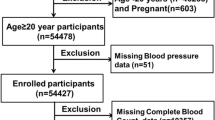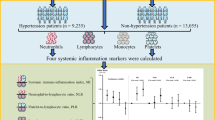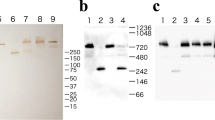Abstract
Evidence suggests long-term chronic inflammation, as the pathological basis of formation and development, plays an important part in atherosclerosis. Immunoglobulins (Igs) provided key information on the humoral immune status. However, few studies have evaluated the correlation between Igs and hypertension and blood pressure (BP) in a general population. We designed a cross-sectional study to evaluate whether serum Ig levels are related to BP and the prevalence of hypertension. About 12,373 participants in Tianjin, China were recruited for this study. Hypertension was diagnosed according to the criteria of the JNC 7 and serum levels of Igs were determined by the immunonephelometric technique. Multiple logistic regression analysis and analysis of covariance were used to assess relationships between serum Ig concentrations and the prevalence of hypertension and BP. The overall prevalence of hypertension was 35.5%. The means (standard deviation) of immunoglobulins [immunoglobulin G (IgG), immunoglobulin E (IgE), immunoglobulin M (IgM), and immunoglobulin A (IgA)] were 1206.0 (249.0) mg/dL, 93.8 (235.4) IU/mL, 105.3 (56.8) mg/dL, and 236.7 (98.1) mg/dL, respectively. The multivariable-adjusted odds ratios (95% confidence interval) of hypertension for the highest immunoglobulins (IgG, IgE, IgM, and IgA) quintile, when compared to the lowest quintile were 1.10 (0.96–1.26), 1.04 (0.91–1.19), 0.83 (0.72–0.96), and 1.32 (1.15–1.51), respectively. Decreased IgM and increased IgG and IgA were related to a higher prevalence of hypertension. IgM was negatively correlated with BP, while IgG and IgA were positively correlated with BP.
This is a preview of subscription content, access via your institution
Access options
Subscribe to this journal
Receive 12 digital issues and online access to articles
$119.00 per year
only $9.92 per issue
Buy this article
- Purchase on Springer Link
- Instant access to full article PDF
Prices may be subject to local taxes which are calculated during checkout
Similar content being viewed by others
References
Andersson C, Gislason GH, Weeke P, Kjaergaard J, Hassager C, Akkan D, et al. The prognostic importance of a history of hypertension in patients with symptomatic heart failure is substantially worsened by a short mitral inflow deceleration time. BMC Cardiovasc Disord. 2012;12:30.
Wang J, Zhang L, Wang F, Liu L, Wang H. China National Survey of Chronic Kidney Disease Working G. Prevalence, awareness, treatment, and control of hypertension in China: results from a national survey. Am J Hypertens. 2014;27:1355–61.
Wang JG. Chinese hypertension guidelines. Pulse (Basel). 2015;3:14–20.
Trott DW, Harrison DG. The immune system in hypertension. Adv Physiol Educ. 2014;38:20–4.
Venegas-Pont M, Manigrasso MB, Grifoni SC, LaMarca BB, Maric C, Racusen LC, et al. Tumor necrosis factor-alpha antagonist etanercept decreases blood pressure and protects the kidney in a mouse model of systemic lupus erythematosus. Hypertension. 2010;56:643–9.
Xiao L, Kirabo A, Wu J, Saleh MA, Zhu L, Wang F, et al. Renal denervation prevents immune cell activation and renal inflammation in angiotensin II-induced hypertension. Circ Res. 2015;117:547–57.
Justin Rucker A, Crowley SD. The role of macrophages in hypertension and its complications. Pflug Arch. 2017;469:419–30.
Itani HA, McMaster WG Jr., Saleh MA, Nazarewicz RR, Mikolajczyk TP, Kaszuba AM, et al. Activation of human T cells in hypertension: studies of humanized mice and hypertensive humans. Hypertension. 2016;68:123–32.
Matsuura E, Kobayashi K, Inoue K, Shoenfeld Y. Intravenous immunoglobulin and atherosclerosis. Clin Rev Allergy Immunol. 2005;29:311–9.
Tsiantoulas D, Diehl CJ, Witztum JL, Binder CJ. B cells and humoral immunity in atherosclerosis. Circ Res. 2014;114:1743–56.
Karvonen J, Paivansalo M, Kesaniemi YA, Horkko S. Immunoglobulin M type of autoantibodies to oxidized low-density lipoprotein has an inverse relation to carotid artery atherosclerosis. Circulation. 2003;108:2107–12.
Tsimikas S, Brilakis ES, Lennon RJ, Miller ER, Witztum JL, McConnell JP, et al. Relationship of IgG and IgM autoantibodies to oxidized low density lipoprotein with coronary artery disease and cardiovascular events. J Lipid Res. 2007;48:425–33.
Tsimikas S, Willeit P, Willeit J, Santer P, Mayr M, Xu Q, et al. Oxidation-specific biomarkers, prospective 15-year cardiovascular and stroke outcomes, and net reclassification of cardiovascular events. J Am Coll Cardiol. 2012;60:2218–29.
Lichtman AH, Binder CJ, Tsimikas S, Witztum JL. Adaptive immunity in atherogenesis: new insights and therapeutic approaches. J Clin Invest. 2013;123:27–36.
Yla-Herttuala S, Palinski W, Butler SW, Picard S, Steinberg D, Witztum JL. Rabbit and human atherosclerotic lesions contain IgG that recognizes epitopes of oxidized LDL. Arterioscler Thromb. 1994;14:32–40.
Muscari A, Bozzoli C, Gerratana C, Zaca F, Rovinetti C, Zauli D, et al. Association of serum IgA and C4 with severe atherosclerosis. Atherosclerosis. 1988;74:179–86.
Muscari A, Bozzoli C, Puddu GM, Rovinetti C, Vallar G, Renzi C, et al. Increased serum IgA levels in subjects with previous myocardial infarction or other major ischemic events. Cardiology. 1993;83:383–9.
Ebringer A, Doyle AE. Raised serum IgG levels in hypertension. Br Med J. 1970;2:146–8.
Adlin EV, Moctezuma J, Marks AD, Moctezuma J, Channick BJ. Serum immunoglobulins in hypertension. Hypertension. 1979;1:650–3.
Liu L, Gu Y, Li C, Zhang Q, Meng G, Wu H, et al. Serum uric acid is an independent predictor for developing prehypertension: a population-based prospective cohort study. J Hum Hypertens. 2017;31:116–20.
Small EM, Frost RJ, Olson EN. MicroRNAs add a new dimension to cardiovascular disease. Circulation. 2010;121:1022–32.
Dzielak DJ. The immune system and hypertension. Hypertension. 1992;19(Suppl):I36–44.
Olsen F. Arteriolar permeability and destruction of elastic membrane in hypertension. Acta Pathol Microbiol Scand. 1969;75:527–36.
Weir DM. The immunologicial consequences of cell death. Lancet. 1967;2:1071–3.
Park SH, Chen WC, Durmus N, Bleck B, Reibman J, Riemekasten G, et al. The Effects of antigen-specific IgG1 antibody for the pulmonary-hypertension-phenotype and B cells for inflammation in mice exposed to antigen and fine particles from air pollution. PLoS ONE. 2015;10:e0129910.
Wu R, de Faire U, Lemne C, Witztum JL, Frostegard J. Autoantibodies to OxLDL are decreased in individuals with borderline hypertension. Hypertension. 1999;33:53–59.
Kerr MA. Function of immunoglobulin A in immunity. Gut. 2000;47:751–2.
Snoeck V, Peters IR, Cox E. The IgA system: a comparison of structure and function in different species. Vet Res. 2006;37:455–67.
Honour J. The possible involvement of intestinal bacteria in steroidal hypertension. Endocrinology. 1982;110:285–7.
Dolle L, Tran HQ, Etienne-Mesmin L, Chassaing B. Policing of gut microbiota by the adaptive immune system. BMC Med. 2016;14:27.
Wang J, Cheng X, Xiang MX, Alanne-Kinnunen M, Wang JA, Chen H, et al. IgE stimulates human and mouse arterial cell apoptosis and cytokine expression and promotes atherogenesis in Apoe-/- mice. J Clin Invest. 2011;121:3564–77.
Jeziorska M, McCollum C, Woolley DE. Mast cell distribution, activation, and phenotype in atherosclerotic lesions of human carotid arteries. J Pathol. 1997;182:115–22.
Magen E, Mishal J, Vardy D. Selective IgE deficiency and cardiovascular diseases. Allergy Asthma Proc. 2015;36:225–9.
Acknowledgements
This study was supported by grants from the National Natural Science Foundation of China (No. 81673166, 81372118, 81372467 and 81302422), the key technologies R&D program of Tianjin (Key Project: No. 11ZCGYSY05700, 12ZCZDSY20400, 13ZCZDSY20200, and 15YFYZSY00020), the National Science and Technology Support Program (No. 2012BAI02B02), 2012 and 2016 Chinese Nutrition Society (CNS) Nutrition Research Foundation—DSM Research Fund (No. 2014-071, 2016-046 and 2016-023), the Technologies development program of Beichen District of Tianjin (No. bcws2013-21, bcws2014-05 and 2015-SHGY-02), the technologies project of Tianjin Binhai New Area (No. 2013-02-04 and 2013-02-06), the Science Foundation of Tianjin Medical University (No. 2010KY28 and 2013KYQ24), the Key Laboratory of Public Health Safety (Fudan University), Ministry of Education (No. GW2014-5), and the National Training Programs of Innovation and Entrepreneurship for Undergraduates (No. 201510062013), China.
Author information
Authors and Affiliations
Corresponding authors
Ethics declarations
Conflict of interest
The authors declare that they have no conflict of interest.
Rights and permissions
About this article
Cite this article
Wang, X., Li, Y., Li, H. et al. Relationship of serum immunoglobulin levels to blood pressure and hypertension in an adult population. J Hum Hypertens 32, 212–218 (2018). https://doi.org/10.1038/s41371-018-0029-2
Received:
Revised:
Accepted:
Published:
Issue Date:
DOI: https://doi.org/10.1038/s41371-018-0029-2
This article is cited by
-
Comparison of Serum Total IgA Levels in Severe and Mild COVID-19 Patients and Control Group
Journal of Clinical Immunology (2022)
-
Association between serum markers of the humoral immune system and inflammation in the Swedish AMORIS study
BMC Immunology (2021)



